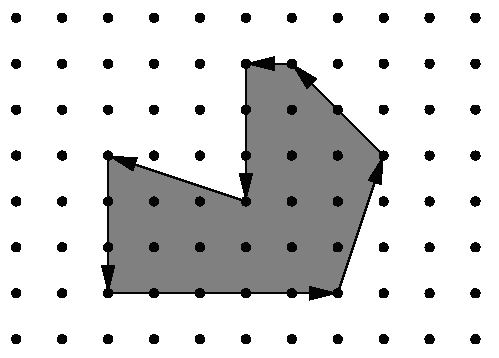poj 1265(pick定理和三角形面积)
来源:互联网 发布:java魔术数字 编辑:程序博客网 时间:2024/04/29 19:23
Area
Time Limit: 1000MS Memory Limit: 10000KTotal Submissions: 4805 Accepted: 2175
Description
Being well known for its highly innovative products, Merck would definitely be a good target for industrial espionage. To protect its brand-new research and development facility the company has installed the latest system of surveillance robots patrolling the area. These robots move along the walls of the facility and report suspicious observations to the central security office. The only flaw in the system a competitor抯 agent could find is the fact that the robots radio their movements unencrypted. Not being able to find out more, the agent wants to use that information to calculate the exact size of the area occupied by the new facility. It is public knowledge that all the corners of the building are situated on a rectangular grid and that only straight walls are used. Figure 1 shows the course of a robot around an example area.

Figure 1: Example area.
You are hired to write a program that calculates the area occupied by the new facility from the movements of a robot along its walls. You can assume that this area is a polygon with corners on a rectangular grid. However, your boss insists that you use a formula he is so proud to have found somewhere. The formula relates the number I of grid points inside the polygon, the number E of grid points on the edges, and the total area A of the polygon. Unfortunately, you have lost the sheet on which he had written down that simple formula for you, so your first task is to find the formula yourself.

Figure 1: Example area.
You are hired to write a program that calculates the area occupied by the new facility from the movements of a robot along its walls. You can assume that this area is a polygon with corners on a rectangular grid. However, your boss insists that you use a formula he is so proud to have found somewhere. The formula relates the number I of grid points inside the polygon, the number E of grid points on the edges, and the total area A of the polygon. Unfortunately, you have lost the sheet on which he had written down that simple formula for you, so your first task is to find the formula yourself.
Input
The first line contains the number of scenarios.
For each scenario, you are given the number m, 3 <= m < 100, of movements of the robot in the first line. The following m lines contain pairs 揹x dy�of integers, separated by a single blank, satisfying .-100 <= dx, dy <= 100 and (dx, dy) != (0, 0). Such a pair means that the robot moves on to a grid point dx units to the right and dy units upwards on the grid (with respect to the current position). You can assume that the curve along which the robot moves is closed and that it does not intersect or even touch itself except for the start and end points. The robot moves anti-clockwise around the building, so the area to be calculated lies to the left of the curve. It is known in advance that the whole polygon would fit into a square on the grid with a side length of 100 units.
For each scenario, you are given the number m, 3 <= m < 100, of movements of the robot in the first line. The following m lines contain pairs 揹x dy�of integers, separated by a single blank, satisfying .-100 <= dx, dy <= 100 and (dx, dy) != (0, 0). Such a pair means that the robot moves on to a grid point dx units to the right and dy units upwards on the grid (with respect to the current position). You can assume that the curve along which the robot moves is closed and that it does not intersect or even touch itself except for the start and end points. The robot moves anti-clockwise around the building, so the area to be calculated lies to the left of the curve. It is known in advance that the whole polygon would fit into a square on the grid with a side length of 100 units.
Output
The output for every scenario begins with a line containing 揝cenario #i:� where i is the number of the scenario starting at 1. Then print a single line containing I, E, and A, the area A rounded to one digit after the decimal point. Separate the three numbers by two single blanks. Terminate the output for the scenario with a blank line.
Sample Input
241 00 1-1 00 -175 01 3-2 2-1 00 -3-3 10 -3
Sample Output
Scenario #1:0 4 1.0Scenario #2:12 16 19.0
Source
Northwestern Europe 2001
参考:http://www.cnblogs.com/Enumz/p/3886538.html
AC代码:
#include<iostream>#include<algorithm>#include<iomanip>#include<cmath>using namespace std;int I,E; //pick定理 A=I + E/2 -1double A;double cross_product(int x1,int y1,int x2,int y2){ double tmp=(x1*y2-x2*y1+0.0)/2; return tmp;}int gcd(int a,int b){ if(a<b){ int tmp=a; a=b; b=tmp; } while(b){ int tmp=a%b; a=b; b=tmp; } return a;}int main(){ int T; cin>>T; for(int cas=1;cas<=T;cas++){ int a,b,n; cin>>n; int x,y,nx,ny; I=E=A=0; x=0; y=0; for(int i=0;i<n;i++){ cin>>a>>b; E+=gcd(abs(a),abs(b)); //最大公约数的和为边(x,y)——(nx,ny)上的点 nx=x+a; ny=y+b; A+=cross_product(x,y,nx,ny); //(0,0)为起点,把多边形分成多个三角形,叉积的绝对值得一半为该三角形的面积 x=nx; y=ny; } A=fabs(A); I=A+1-E/2; cout<<"Scenario #"<<cas<<":"<<endl; cout<<I<<' '<<E<<' '; cout<<setprecision(1)<<setiosflags(ios::fixed)<<A<<endl<<endl; } return 0;} 0 0
- poj 1265(pick定理和三角形面积)
- POJ 1265 Area (Pick定理&多边形面积)
- poj 1265 <Pick定理求面积>
- POJ 1265 Area (有向面积, pick 定理)
- 【POJ 1265】 Area (Pick定理+叉积求多边形面积)
- POJ 1265 Area pick定理 + 多边形面积求法
- POJ 1265 Area(Pick定理、向量积求面积)
- poj 1265(pick 定理)
- POJ 1265 Pick定理
- poj 1265 pick定理
- POJ 1265 pick定理
- POJ 1265 pick定理
- POJ 1265 pick 定理
- POJ 1265 Pick 定理
- pku2694三角形面积 pick
- poj-1265-Area-pick定理
- POJ 1265 Area Pick定理
- POJ 1265 Area(Pick定理)
- 初创公司[只差程序员]解决之道(一)
- 大数据离我们有多远?
- 实例详解Django的 select_related 和 prefetch_related 函数对 QuerySet 查询的优化(二)
- Android 非UI线程中更新UI
- Ubuntu 虚拟机环境搭建
- poj 1265(pick定理和三角形面积)
- dma
- 十个面向对象设计原则
- 获取网络图片(Bitmap)至内存或者SD卡
- 纪念下自己代码人生的一小步,自己写出的华为2015招聘题目
- 汇编英文全称
- protocol
- ERP
- NYOJ 613免费馅饼


